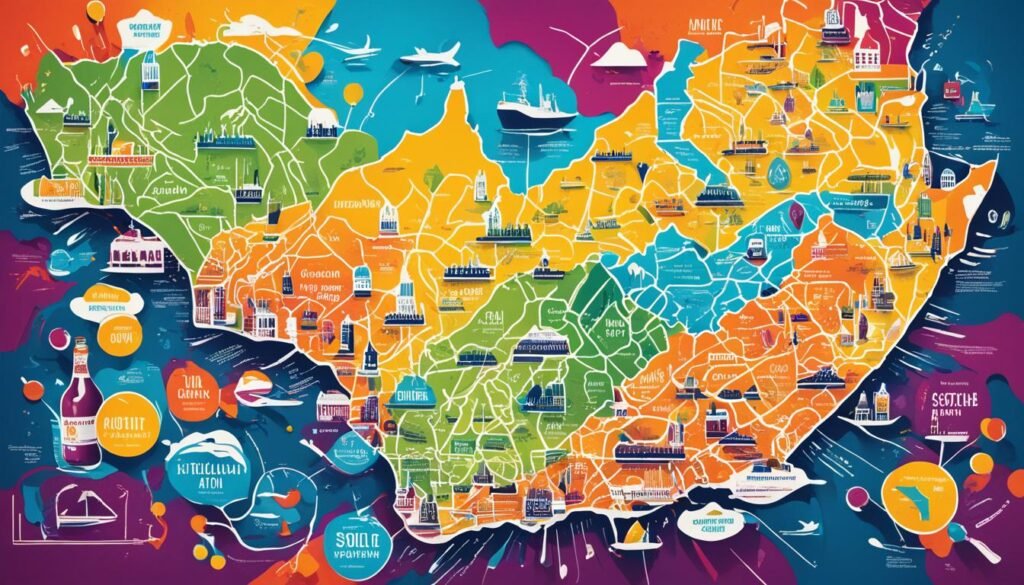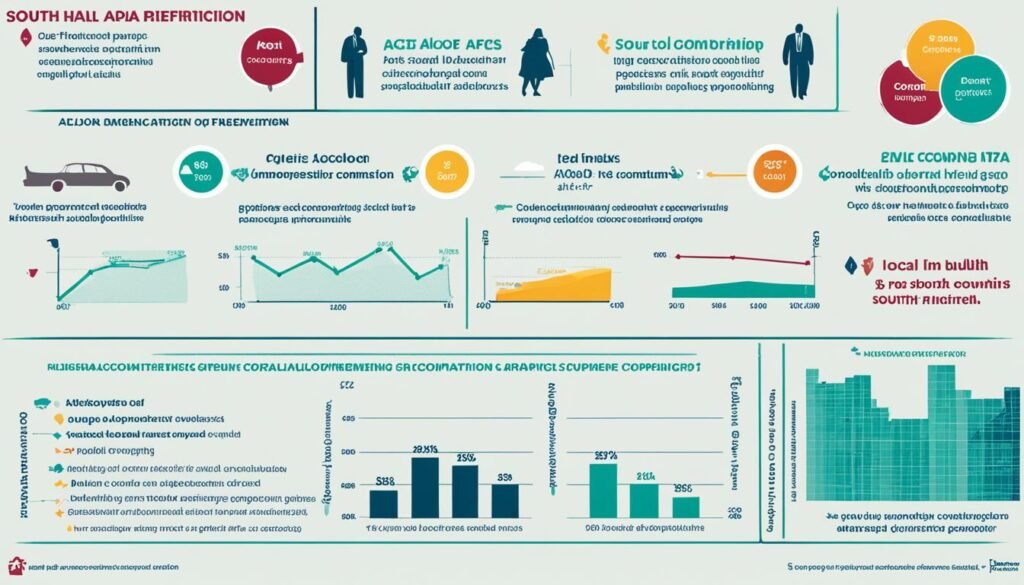Understanding which province drinks the most alcohol in South Africa uncovers important social and health dynamics within the country. As current studies highlight, South Africa alcohol consumption rate is particularly notable in its wine-rich region, placing the Western Cape as the South African province with the highest alcohol consumption. The heightened prevalence of alcohol use not only puts a strain on public health but also propels government authorities to evaluate and enforce policy measures. The Western Cape’s unique relationship with alcohol opens up critical discussions on the balance between cultural practices, economic implications, and the well-being of its inhabitants.
Key Takeaways
- The Western Cape leads in alcohol consumption per capita in South Africa
- Policy proposals in the Western Cape aim to curb alcohol-related harm
- University of Cape Town studies model the economic and health impacts of alcohol
- Risky drinking behaviors reflect broader societal challenges
- Effective policies can lead to significant healthcare and crime prevention savings
- Comprehensive strategies are needed to mitigate the societal effects of alcohol use
Unveiling South Africa’s Alcohol Consumption Trends
As we delve into the various patterns of alcohol usage across the nation, it becomes imperative to analyze the South Africa alcohol statistics for a clearer understanding of the landscape. With the comprehensive data collected from the South Africa Demographic and Health Survey (SADHS), an intricate picture of the country’s drinking habits emerges.
Understanding National Drinking Patterns
The 2016 SADHS, conducted by StatsSA, is a crucial benchmark in charting the trajectory of alcohol and tobacco use. It points to a decline in tobacco smoking, accompanying a discerning analysis of alcohol uptake among varying demographics. Alcohol consumption in South Africa provinces reflects diverse socio-economic influences, notably urbanization, affecting drinking behaviors. The survey reports that a staggering 61% of men and 26% of women aged 15 and over acknowledge alcohol use, with a significant portion partaking in high-risk drinking practices. These statistics not only illustrate nationwide consumption trends but also highlight the public health implications of such habits.
Alcohol Consumption in South Africa Provinces
Scrutinizing drinking behaviors further, the SADHS data highlights the contrast in Alcohol consumption by province in South Africa. The Western Cape and the Northern Cape demonstrate alarmingly high rates of risky drinking. On the other end of the spectrum, Limpopo and KwaZulu-Natal report considerably lower levels of alcohol and cigarette use among women. This data underscores the stark regional disparities prevalent in the country. A closer look at South Africa alcohol consumption data reveals a pattern where the Western Cape, Northern Cape, and North West occupy the top tiers of alcohol consumption metrics. These patterns underscore the pressing need for targeted policies to address the unique challenges faced by different provinces.
Which province drinks the most alcohol in South Africa?
With a comprehensive analysis of reports from various governmental organizations, health surveys, and academic studies, it is evident that the South African province with the highest alcohol consumption is the Western Cape. This region exhibits an alarming South Africa alcohol consumption rate, surpassing other provinces significantly. These findings pose critical questions about public health and safety policy in the area.
The statistics are not just mere numbers but reflect underlying social and economic issues that call for immediate and effective policy intervention. To provide a clearer picture of the statistics, a detailed table is presented below to showcase the alcohol consumption rates across the provinces:
| Province | Alcohol Consumption Rate (% of population) | National Average Comparison |
|---|---|---|
| Western Cape | Highest | 30%-40% above average |
| Gauteng | Moderate | Around average |
| KwaZulu-Natal | Lower | Well below average |
| Limpopo | Lowest | Significantly below average |
| Northern Cape | High | Above average |
| Other Provinces | Varied | — |
The contrasting consumption rates across the provinces underscore the complexity of alcohol-related challenges faced by South Africa. Highlighting the Western Cape as the South African province with highest alcohol consumption provides a foundation for targeted interventions. Policy-makers must use these insights to develop localized strategies that can effectively decrease the overall South Africa alcohol consumption rate.
As we continue examining the factors contributing to these rates, it becomes imperative to consider both urban and rural consumption patterns, availability of alcohol, cultural aspects, and economic conditions that may influence these statistics.
The Remarkable Case of the Western Cape

The Western Cape stands out in discussions about South Africa alcohol consumption. Its per capita rates not only surpass most other regions in the nation but are a cause for concern among policy-makers and health advocates alike. A substantial deviation of 30%-40% above the national average signals a pressing need for targeted legislative actions.
Per Capita Alcohol Consumption Statistics
When examining alcohol consumption in South African provinces, it becomes clear that the Western Cape has a unique challenge on its hands. This isn’t simply anecdotal; numerous studies corroborate these figures, painting a vivid picture of the scale of alcohol consumption within the region. Such elevated statistics have catalyzed the drive for policy reform designed to curb these excessive rates and preempt the fallout on public health systems and societal welfare.
Proposed Policies to Curb Excessive Drinking
In response to the high South Africa alcohol consumption rate, there is considerable advocacy for change. The Western Cape government, armed with data and international precedents, is considering revising current alcohol policies. Specifically, a proposal to reduce on-site consumption hours looms as a pivotal move that might steer consumption towards healthier metrics. The University of Cape Town adds an academic heft to this discussion, providing rigorous models that demonstrate the possible beneficial outcomes of such policies. These studies are invaluable, as they not only predict tangible health benefits but also sketch the economic landscape that would follow such significant changes to alcohol regulations.
Overall, Section 4 underscores the distinctive challenges the Western Cape faces in terms of alcohol consumption trends in South Africa. Through understanding the provincial data and proposed policy interventions, the spotlight shines on the need for action in reducing the alcohol consumption rate in the region, which is pivotal for safeguarding its community’s future.
The Economic and Health Impact of Reducing Onsite Alcohol Consumption

As South Africa grapples with the implications of its alcohol consumption trends, a pivotal study by the University of Cape Town presents data-driven insights into how onsite alcohol consumption restrictions could not only reshape public health paradigms but also steer economic outcomes in new directions. The connection between trading hours for alcohol and the subsequent influence on societal well-being and fiscal stability is a critical focal point for policymakers and citizens alike.
Modeling the Effects of Restricted Trading Hours
According to South Africa alcohol consumption data, evolving measures to regulate trading hours for alcohol sales could pivotally reduce alcohol consumption rates. This reduction plays an instrumental role in curbing alcohol-related health issues and antisocial behaviors. The research methodology employs comprehensive models that utilize historical South Africa alcohol consumption trends, offering a forecast of potential public health benefits and economic savings that could occur through systematically implemented restrictions.
Projected Savings on Healthcare and Crime Prevention
The intersection of health and economics comes to light when the South Africa alcohol consumption rate is juxtaposed with the costs incurred by healthcare facilities and law enforcement. The study’s projections—based on meticulous data analysis—suggest that limiting alcohol trade hours can lead to a decrease in both alcohol-related admissions to healthcare establishments and incidents requiring police intervention. This interplay presents a multi-faceted perspective on the ripple effects such policy changes could have from urban cities to provincial townships throughout South Africa.
| Scenario | Healthcare Savings (Over 20 Years) | Immediate Tax Revenue Impact | Anticipated Crime Reduction |
|---|---|---|---|
| Trade hours limited to midnight | R326.8 million – R890.2 million | R100 million – R333 million decrease | Notable decrease in alcohol-related crimes |
| Early evening closing times | Potential to exceed R890.2 million | Greater than R333 million decrease | Significant decrease in night-time offenses |
Integral to policy discourse and civic consideration is the interdependency of South Africa alcohol consumption trends and the country’s socio-economic fabric. By illuminating the anticipated benefits of reduced alcohol availability, this research underscores the number 6 as a symbolic turning point, representing a potential step towards harnessing more responsible alcohol consumption patterns and their positive societal impact.
Alcohol Use and its Societal Effects
The impact of alcohol consumption on South African society is both profound and multifaceted. A significant contributor to various health issues, the habit of excessive drinking has been associated with a host of diseases, trauma-related injuries and has been implicated in the exacerbation of violent crimes, including gender-based violence. In examining alcohol consumption by province in South Africa, disproportionate numbers reveal a troubling pattern, with certain regions reporting higher instances of alcohol-related disorders and social disturbances. As South Africa grapples with this challenge, it’s imperative that concerted efforts are directed towards addressing the ramifications of alcohol abuse on both individual health and societal well-being.
Association with Diseases and Violent Crimes
In South Africa, alcohol consumption is a risk factor in over 200 health conditions and has become tightly interwoven with societal issues such as violent crime and domestic abuse. The correlation is alarming, and the call for effective intervention strategies resonates across communities, particularly in provinces identified as hotspots for high alcohol consumption. The need to adapt a proactive stance against the negative consequences of alcohol misuse is urgent, providing a clear mandate for the implementation of evidence-based solutions tailored to these regions.
Policy Interventions and Alcohol Harm Reduction
Emphasizing a strategic approach, the Western Cape’s Alcohol Harms Reduction White Paper serves as a blueprint for curbing the detrimental effects of alcohol in society. Alongside the proposed reduction in liquor trading hours, a suite of policy interventions such as advertising bans, price controls, stricter enforcement of drinking and driving laws, and the expansion of treatment services for alcohol dependence comes into view. These initiatives are designed to forge a comprehensive policy framework, aiming to diminish the harm caused by alcohol in South Africa, from the personal loss of health and life to the broader social and economic costs.
Alcohol Use and its Societal Effects
Which province drinks the most alcohol in South Africa?
The Western Cape is recognized as the province that drinks the most alcohol in South Africa, with per capita alcohol consumption estimated to be 30%-40% higher than the national average.
What is South Africa’s alcohol consumption rate?
While specific rates may vary by source and year, South Africa has one of the highest per capita alcohol consumption rates in Africa. Data from surveys suggest significant alcohol use, with 61% of men and 26% of women over the age of 15 reporting alcohol consumption.
Understanding National Drinking Patterns
National drinking patterns in South Africa show considerable alcohol consumption among adults. Surveys like the South Africa Demographic and Health Survey (SADHS) indicate that a sizable percentage of adults engage in alcohol use, with a considerable portion participating in risky drinking behaviors.
Alcohol Consumption in South Africa Provinces
Alcohol consumption rates in South Africa’s provinces vary significantly. The Western and Northern Cape provinces exhibit relatively high risky drinking rates, while Limpopo and KwaZulu-Natal report lower prevalence rates for alcohol consumption and smoking, particularly among women.
What are the South Africa alcohol statistics by province?
Detailed alcohol statistics by province can be found through governmental health surveys and research projects. The Western Cape consistently reports higher alcohol consumption rates. Other provinces such as the Northern Cape and North West also have notable consumption, while Limpopo and KwaZulu-Natal tend to report lower statistics.
Per Capita Alcohol Consumption Statistics
In the Western Cape, per capita alcohol consumption significantly exceeds that of other provinces in South Africa, with estimates placing it at 30%-40% above the national average.
Proposed Policies to Curb Excessive Drinking
The Western Cape government has proposed limiting trading hours for the onsite consumption of alcohol as a policy to address excessive drinking. Academic studies have been conducted to predict the consequences of such policies on public health and economy.
Modeling the Effects of Restricted Trading Hours
The University of Cape Town conducted modeling studies to evaluate the health and economic impacts of implementing restricted trading hours for alcohol sales. Predictions include life-saving benefits, reduced incidence of alcohol-related diseases and injuries, and decreased costs for hospitals and crime prevention.
Projected Savings on Healthcare and Crime Prevention
Models suggest that curtailing trading hours to midnight could result in hospital cost savings ranging from R326.8 million to R890.2 million over twenty years, alongside significant reductions in alcohol consumption, alcohol-related tax revenues, and crime rates.
Association with Diseases and Violent Crimes
Alcohol use in South Africa is linked to over 200 different diseases, injuries, and medical conditions. It is also regarded as a contributory factor to gender-based violence and other forms of violent crime.
Policy Interventions and Alcohol Harm Reduction
The Western Cape’s proposed alcohol policies, informed by local studies and the World Health Organization, aim to reduce the harmful effects of excessive alcohol consumption through measures like restricted trading hours, advertising bans, minimum pricing strategies, and improved treatment access for alcohol dependence.
